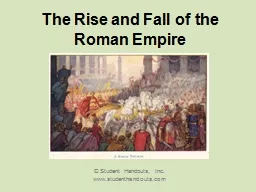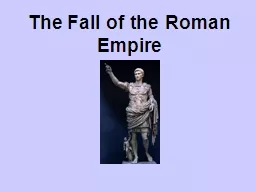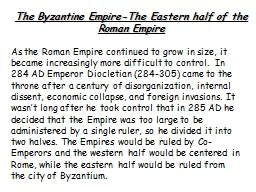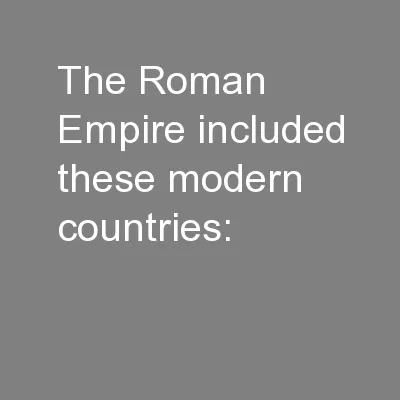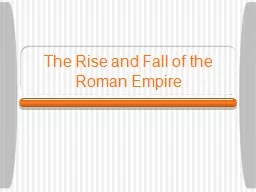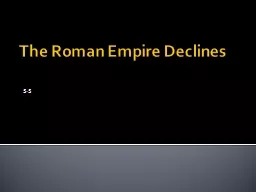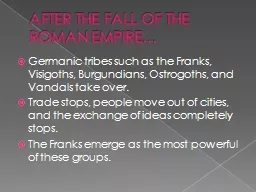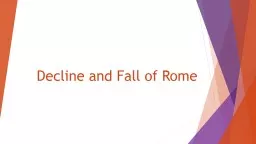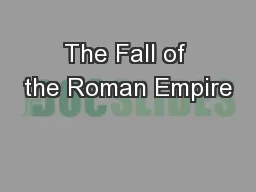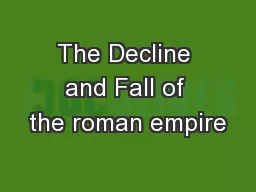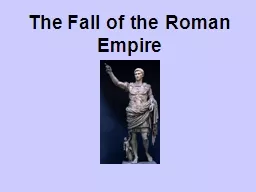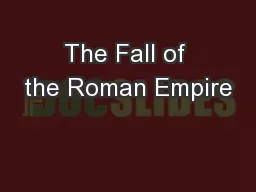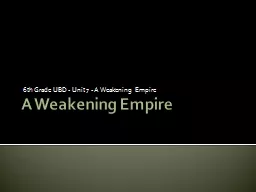PPT-The Rise and Fall of the Roman Empire
Author : mofferro | Published Date : 2020-07-03
Student Handouts Inc wwwstudenthandoutscom What was the Roman Empire There were two periods of Roman government Roman Republic 509 BCE30 BCE Roman Empire 30 BCE476
Presentation Embed Code
Download Presentation
Download Presentation The PPT/PDF document "The Rise and Fall of the Roman Empire" is the property of its rightful owner. Permission is granted to download and print the materials on this website for personal, non-commercial use only, and to display it on your personal computer provided you do not modify the materials and that you retain all copyright notices contained in the materials. By downloading content from our website, you accept the terms of this agreement.
The Rise and Fall of the Roman Empire: Transcript
Student Handouts Inc wwwstudenthandoutscom What was the Roman Empire There were two periods of Roman government Roman Republic 509 BCE30 BCE Roman Empire 30 BCE476 CE Rome technically had an empire under the Roman Republic. © Student Handouts, Inc.. www.studenthandouts.com. What was the Roman Empire?. There were two periods of Roman government.. Roman Republic . 509 BCE-30 BCE. Roman Empire. 30 BCE-476 CE. Rome technically had an “empire” under the Roman Republic.. The Roman Empire at its Height. The Roman Empire became huge. It covered most of Europe, North Africa, and some of Asia. The Empire reached its height under Emperor Diocletian (284-305 CE). The Decline Begins. What internal and external problems destroyed Rome?. A New Emperor. From the end of Diocletian’s reign as emperor in . 305 CE . until . 312 CE . there was fighting in the Roman empire (chaos and disunity…). . The Byzantine Empire-The Eastern half of the Roman Empire. The dividing line was chosen because most territories to the west of the line spoke Latin and followed traditional Roman culture, while the territories to the east spoke Greek and maintained less traditional Roman ways.. Portugal. Spain. Andorra. United Kingdom. France. Monaco. Luxembourg. Belgium. Netherlands. Germany. Switzerland. Liechtenstein. Italy. San Marino. Vatican City. Malta. Austria. Czech Republic. Slovakia. Rome built great stuff. Rome built great roads to travel on and aqueducts to bring water into the city.. Rome also built great stadiums and amphitheaters for the entertainment of the people.. Romans also developed the use of the arch. . 5.5. What caused the Decline?. Economic Problems. Foreign Invasion. Decline in traditional values. Dividing the Roman Empire. Political Violence. The . Pax. . Romana. comes to an end with the death of Marcus Aurelius in 180. Germanic tribes such as the Franks, Visigoths, . Burgundians. , . Ostrogoths. , and Vandals take over.. Trade stops, people move out of cities, and the exchange of ideas completely stops.. The Franks emerge as the most powerful of these groups.. Empire in Crisis. The . Pax. . Romana. ends in AD 180. Power taken by a series of short-lived emperors. High taxes on citizens. Poor farmers work for the wealthy in partial slavery. Diocletian . Ruled as Emperor from AD 284 – 305. He was very strict. Instructions. Get out a blank piece of paper. Write “Downfall of Rome” on the top of your paper. Write the title for each slide on your paper. Skip a line, indent and write only the words in . red. Chapter 11, Section 3. THE BEGINNING OF THE END:. THE DECLINE. The . Pax. . romana. Translated means “Roman Peace”. Began with the reign of Augustus and ended with the death of Marcus Aurelius. Rome . The Roman Empire at its Height. The Roman Empire became huge. It covered most of Europe, North Africa, and some of Asia. The Empire reached its height under Emperor Diocletian (284-305 CE). Expansion: Good or Bad?. The Roman Empire at its Height. The Roman Empire became huge. It covered most of Europe, North Africa, and some of Asia. The Empire reached its height under Emperor Diocletian (284-305 CE). Expansion: Good or Bad?. Preview. Decline. -. After the year 180, political, geographic, and cultural factors made the Roman Empire weaker. Finally, it fell into decline.. Diocletian and Constantine. - . Diocletian returned order and organization to the empire. Constantine totally changed the way the empire was run..
Download Document
Here is the link to download the presentation.
"The Rise and Fall of the Roman Empire"The content belongs to its owner. You may download and print it for personal use, without modification, and keep all copyright notices. By downloading, you agree to these terms.
Related Documents

